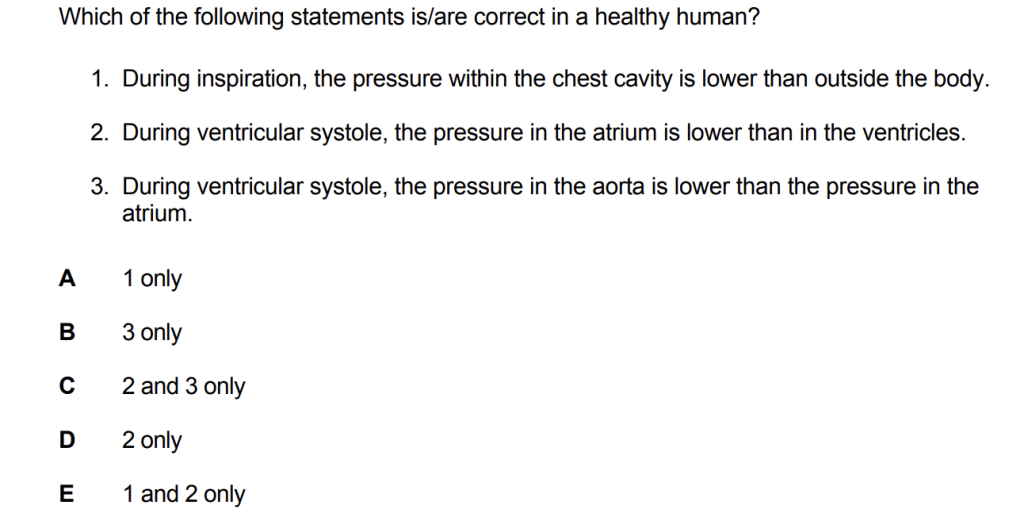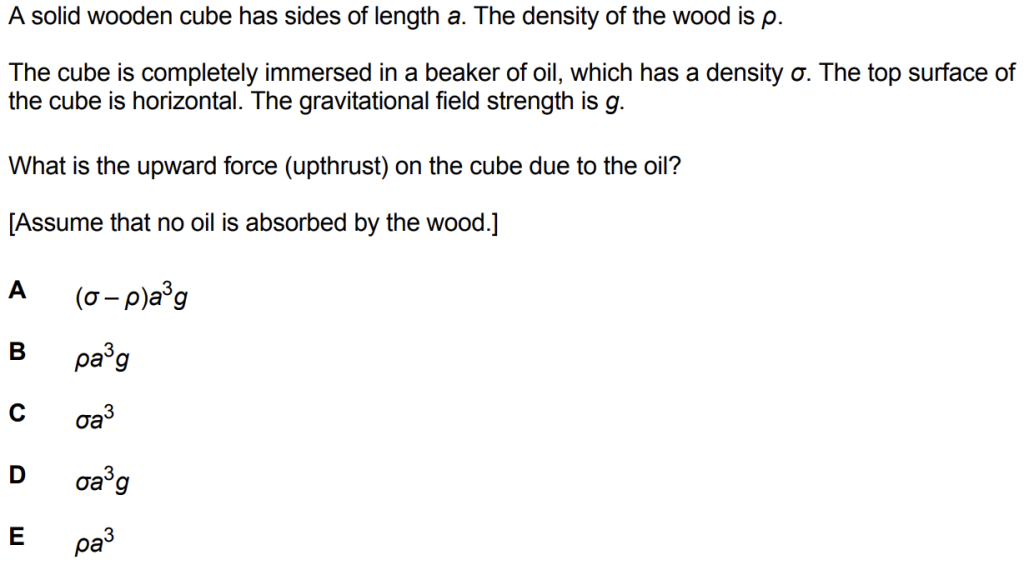

Paris University of Pavia | Ari's Past Student (2020)
18th of April, 2023The International Medical Admissions Test (IMAT) is a demanding and highly competitive exam taken by aspiring medical students from around the world who wish to study at Italian universities that offer medical courses in English. The exam is designed to assess candidates’ aptitude for critical thinking, problem-solving, and scientific knowledge. It is essential for students to thoroughly prepare for this exam to increase their chances of success in securing a place in their desired medical program.
Content Quick Navigation
The IMAT 2017 consisted of 60 multiple-choice questions, divided into the following sections:
- Logical Reasoning and General Knowledge (20 questions)
- Biology (18 questions)
- Chemistry (12 questions)
- Mathematics and Physics (10 questions)
Each correct answer was awarded 1.5 points, while incorrect answers result in a 0.4 point penalty. No points were deducted for unanswered questions.


The fact that not answering questions gives you 0 points should be used to your advantage!
In this article, we will provide an in-depth analysis of the 2017 IMAT paper, focusing on the topics and question types that candidates encountered in each section. Our goal is to provide valuable insights and useful information for future candidates preparing for the IMAT exam.
Logical Reasoning and Problem-Solving
The Logical Reasoning and Problem-Solving section of the IMAT exam is designed to evaluate candidates’ ability to analyze, interpret, and draw logical conclusions from various sources, including texts, tables, and graphs. This section typically features question types such as argument flaws, weakening arguments, strengthening arguments, conclusions, underlying assumptions, and understanding the principle-logical structure. Candidates are expected to demonstrate their skills in logical reasoning, critical thinking, and problem-solving to succeed in this section.
In the 2017 IMAT paper, the Logical Reasoning and Problem-Solving section contained a smaller number of questions compared to other years. The focus was primarily on asking candidates to find conclusions, underlying assumptions, and weakening arguments from passages. In the following sub-sections, we will discuss these key aspects and provide valuable insights for future candidates preparing for the IMAT exam.
Logical Reasoning
Question Types
Finding Conclusions
In the 2017 IMAT paper, candidates were required to identify the main conclusions from passages, testing their ability to understand and extract the central point of an argument. This skill is crucial, as it allows candidates to grasp the essence of a passage quickly and efficiently.
Identifying Underlying Assumptions
Another area of focus in the 2017 IMAT paper was identifying underlying assumptions in the given passages. Candidates needed to determine the implicit premises that support the argument’s conclusion. Recognizing these hidden assumptions is essential for understanding the argument’s structure and evaluating its validity.
Weakening Arguments
The 2017 IMAT paper also tested candidates’ ability to weaken arguments presented in the passages. Candidates were asked to analyze the argument’s structure and identify any flaws, inconsistencies, or vulnerabilities. By understanding how to weaken an argument, candidates can develop their critical thinking skills and become more proficient in evaluating various claims.
General tips for tackling the Logical Reasoning section
As candidates prepare for the IMAT exam, it is crucial to become familiar with the various question types and develop a systematic approach to tackle each type effectively. Here are some general tips for tackling the Logical Reasoning and Problem-Solving section:
- Practice identifying different question types and develop strategies for each type.
- Read passages carefully and focus on understanding the argument’s structure.
- Pay attention to keywords and phrases that signal assumptions, conclusions, or flaws.
- Develop your critical thinking skills by analyzing and evaluating various arguments.
- Time management is essential – allocate sufficient time for each question but avoid spending too much time on a single question.
By incorporating these tips into your preparation strategy, you can increase your chances of success in the Logical Reasoning and Problem-Solving section of the IMAT.
Problem-Solving
The Problem-Solving section of the IMAT exam aims to assess candidates’ ability to apply critical thinking, analytical, and numerical skills to solve complex problems. In the 2017 paper, this section was more challenging than in previous years, featuring a larger number of questions, some of which were quite complex. Candidates were presented with big tables containing data to analyze, which could easily lead to confusion or getting lost.
In this analysis, we will delve into the specifics of the 2017 Problem-Solving section, focusing on the numerical and spatial puzzles that were part of the exam. Our goal is to provide valuable insights and useful information to help future candidates effectively tackle this challenging section.
Numerical Puzzles
The 2017 IMAT paper contained 7 numerical puzzles, which required candidates to apply their mathematical and logical skills to solve problems based on various numerical patterns, sequences, and relationships. These puzzles often demanded a strong grasp of mathematical concepts, along with the ability to think creatively and strategically.
Spatial Puzzles
In addition to the numerical puzzles, the 2017 IMAT paper also featured 2 spatial puzzles. These questions assessed candidates’ ability to visualize and manipulate shapes and objects in two- or three-dimensional space, requiring a combination of spatial awareness, logical reasoning, and problem-solving skills.
Strategies for Tackling the Challenging Problem-Solving Section:
To excel in the Problem-Solving section, especially when encountering complex questions as seen in the 2017 IMAT paper, candidates should consider adopting the following strategies:
- Familiarize yourself with various problem-solving question types, including numerical and spatial puzzles, and practice solving them regularly to build your skills.
- Develop a systematic approach to breaking down complex problems into smaller, manageable components.
- When analyzing data from large tables, focus on identifying patterns and relationships, and use a process of elimination to narrow down possible solutions.
- Enhance your spatial awareness by practicing spatial puzzles that require visualization and manipulation of shapes and objects in two- or three-dimensional space.
- Don’t be afraid to think outside the box and explore creative solutions to challenging problems.
- Manage your time effectively during the exam, allocating sufficient time for each question but being mindful not to spend too much time on a single problem.
By incorporating these strategies into your preparation, you can better equip yourself to face the challenges of the Problem-Solving section and improve your overall performance on the IMAT exam.
General Knowledge
In the 2017 IMAT paper, the General Knowledge section consisted of only two questions, which was more typical for older exams compared to the increased number of general knowledge questions introduced in 2020. Despite the limited number of questions in this section, the topics covered were diverse and challenging, testing candidates’ knowledge on free trade economy theories and requiring them to match scientific theories with the locations where they were announced.
Strategies for Preparing for the General Knowledge Section:
To succeed in the General Knowledge section, candidates should consider the following strategies:
- Regularly read and stay updated on a wide range of topics, including history, literature, philosophy, science, and current events.
- Develop a strong foundation in key theories and concepts across various disciplines, focusing on their historical context and real-world applications.
- Practice recalling specific details related to significant events, theories, and discoveries in the fields of science, economy, and humanities.
- Engage in discussions and debates on various topics to improve your understanding and retention of information.
- Use flashcards, mind maps, and other memory techniques to help remember and organize the information you’ve learned.
By adopting these strategies, candidates can enhance their general knowledge and be better prepared to tackle the diverse and challenging questions that may appear in future IMAT exams.
Biology
The Biology section of the IMAT exam is designed to evaluate candidates’ understanding of fundamental biological concepts and principles. In the 2017 IMAT paper, a diverse range of topics was covered, reflecting the breadth and depth of knowledge required for success in this section. In this analysis, we will discuss these topics by categorizing them into broad themes, providing valuable insights and information for future candidates preparing for the IMAT exam.
| Topic | Number of Questions |
|---|---|
| The chemistry of living things | 2 |
| The cell as a basis of life | 5 |
| Bioenergetics | 2 |
| Reproduction & Inheritance | 1 |
| Inheritance & Environment | 3 |
| Anatomy & Physiology | 5 |
Cellular Processes and Structures
The 2017 IMAT paper featured several questions related to cellular processes and structures, including meiosis, oocyte maturation, nucleic acids, plant cell structures, movement of molecules in cells, structure differences between eukaryotic cells, and bonds in a protein sequence. These topics encompass essential aspects of cell biology, such as reproduction, molecular interactions, and cellular organization.
Human Physiology and Anatomy
Another key theme in the 2017 IMAT paper was human physiology and anatomy. Questions in this category covered topics such as respiratory physiology, pituitary gland function, and human hemoglobin structure. A thorough understanding of the human body’s systems and functions is crucial for aspiring medical students, and these questions tested candidates’ knowledge of these fundamental concepts.


Genetics and Inheritance
The 2017 IMAT paper also included questions on genetics and inheritance, specifically enzyme inhibitors and cystic fibrosis inheritance. These topics required candidates to demonstrate their understanding of the principles of heredity, gene expression, and the role of enzymes in biological processes.
Neurobiology and Memory
The 2017 IMAT paper featured a question related to memory and the central nervous system, exploring the complex relationship between neural networks and cognitive function. Candidates were expected to understand the mechanisms behind memory formation and retrieval, as well as the structure and function of the central nervous system.
Plant Biology and Photosynthesis
Lastly, the 2017 IMAT paper tested candidates’ knowledge of plant biology, specifically photosynthesis. This topic highlights the importance of understanding the fundamental processes that drive life on Earth and the role of plants in sustaining ecosystems.
| Topic | Number of Questions |
|---|---|
| The chemistry of living things | 2 |
| The cell as a basis of life | 5 |
| Bioenergetics | 2 |
| Reproduction & Inheritance | 1 |
| Inheritance & Environment | 3 |
| Anatomy & Physiology | 5 |
Chemistry
The Chemistry section of the IMAT exam assesses candidates’ understanding of fundamental chemical concepts and principles. In the 2017 IMAT paper, several topics were covered, demonstrating the breadth of knowledge required for success in this section. In this analysis, we will discuss these topics by categorizing them into broad themes, providing valuable insights and information for future candidates preparing for the IMAT exam.
| Topic | Number of Questions |
|---|---|
| The composition of matter | 1 |
| Atomic Structure | 2 |
| The periodic table of the elements | 2 |
| The chemical bond | 0 |
| Fundamentals of inorganic chemistry | 1 |
| Chemical reactions and stoichiometry | 2 |
| Solutions | 3 |
| Oxidation and reduction | 1 |
| Acids and bases | 0 |
| Fundamentals of organic chemistry | 0 |
Fundamentals of Chemistry
The 2017 IMAT paper featured questions related to the composition of matter, atomic structure, and the periodic table of the elements. These fundamental topics form the foundation of chemistry, as they explore the building blocks of matter, the organization of elements, and the underlying principles that govern their properties and interactions.
Chemical Bonding and Reactions
Another key theme in the 2017 IMAT paper was chemical bonding and reactions, encompassing questions on chemical bond types, fundamentals of inorganic chemistry, and chemical reactions and stoichiometry. Candidates were expected to understand the nature of chemical bonds, the formation and properties of inorganic compounds, and the principles governing chemical reactions, including balancing equations and calculating stoichiometric relationships.
Solutions and Solubility
This year’s paper also included questions on solutions, with three questions addressing this topic. Candidates were expected to demonstrate their understanding of the properties of solutions, the factors affecting solubility and the principles of concentration calculations.
Oxidation and Reduction
One question in the 2017 IMAT paper focused on oxidation and reduction, requiring candidates to understand the principles of redox reactions, including the identification of oxidizing and reducing agents, and the balancing of redox equations.
Mathematics and Physics
The Mathematics and Physics sections of the IMAT exam evaluate candidates’ understanding of essential concepts and principles in these areas. In the 2017 IMAT paper, a range of topics were covered, reflecting the diversity of knowledge required for success in these sections. In this analysis, we will discuss these topics by categorizing them into broad themes, providing valuable insights and information for future candidates preparing for the IMAT exam.
Physics
The 2017 IMAT paper featured questions related to current resistance, solid submersion in fluid, and ideal gas thermodynamics. These topics cover fundamental concepts in physics, such as electricity, fluid mechanics, and thermodynamics.




Mathematics
In the Mathematics section of the 2017 IMAT paper, candidates encountered questions on:
– the gradient of functions
– logarithmic calculations
– algebraic calculations.
These topics encompass core mathematical principles, such as calculus, logarithms, and algebraic manipulation.
| Topic | Number of Questions |
|---|---|
| Algebra and numerical sets | 3 |
| Functions | 1 |
| Geometry | 1 |
| Probability and statistics | 0 |

